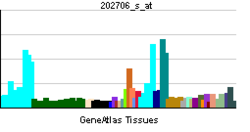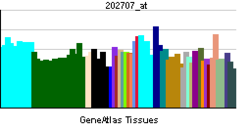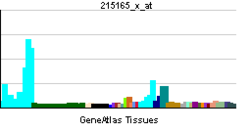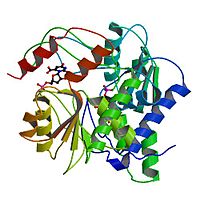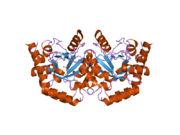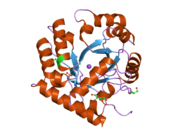- Uridine monophosphate synthetase
-
Uridine monophosphate synthetase (UMPS) (orotate phosphoribosyl transferase and orotidine-5'-decarboxylase) is the enzyme (EC 4.1.1.23) that catalyses the formation of uridine monophosphate (UMP), an energy-carrying molecule in many important biosynthetic pathways.[1] In humans, the gene that codes for this enzyme is located on the long arm of chromosome 3 (3q13).[2]
Contents
Structure and Function
This bifunctional enzyme has two main domains, an orotate phosphoribosyltransferase (OPRTase, EC 2.4.2.10) subunit and an orotidine-5’-phosphate decarboxylase (ODCase, EC 4.1.1.23) subunit.[3] These two sites catalyze the last two steps of the de novo uridine monophosphate (UMP) biosynthetic pathway. After addition of ribose-P to orotate by OPRTase to form orotidine-5’-monophosphate (OMP), OMP is decarboxylated to form uridine monophosphate by ODCase. In microorganisms, these two domains are separate proteins, but in multicellular eukaryotes, the two catalytic sites are expressed on a single protein, uridine monophosphate synthetase.[4]
UMPS exists in various forms, depending on external conditions. In vitro, monomeric UMPS, with a sedimentation coefficient S20,w of 3.6 will become a dimer, S20,w = 5.1 after addition of anions such as phosphate. In the presence of OMP, the product of the OPRTase, the dimer changes to a faster sedimenting form S20,w 5.6.[5][6] These separate conformational forms display different enzymatic activities, with the UMP synthase monomer displaying low decarboxylase activity, and only the 5.6 S dimer exhibiting full decarboxylase activity.[7]
It is believed that the two separate catalytic sites fused into a single protein to stabilize its monomeric form. The covalent union in UMPS stabilizes the domains containing the respective catalytic centers, improving its activity in multicellular organisms where concentrations tend to be 1/10th of the separate counterparts in prokaryotes. Other microorganisms with separated enzymes must retain higher concentrations to keep their enzymes in its more active dimeric form.[8]
Regulation
UMPS is subject to complex regulation by OMP, the product of its OPRTase and the substrate for the ODCase.[9] OMP is an allosteric activator of OMP decarboxylase activity.[6] At low enzyme concentration and low OMP concentrations, OMP decarboxylase shows negative cooperativity, while at higher OMP concentrations, the enzyme shows positive cooperativity. However, when enzyme concentrations are higher, these complex kinetics do not manifest.[9] Orotate PRTase activity is activated by low concentrations of OMP,[10] phosphate,[4] and ADP.[11]
Clinical significance
A UMP synthetase deficiency can result in a metabolic disorder called orotic aciduria.[12]
Deficiency of this enzyme is an inherited autosomal recessive trait in Holstein cattle, and it will cause death before birth.[13]
Deficiency of the enzyme can be studied in the model organism Caenorhabditis elegans. The rad-6 strain has a premature stop codon eliminating the orotidine 5’-decarboxylase domain of the protein; this domain does not occur in any other proteins encoded by the genome. The strain has a pleiotropic phenotype including reduced viability and fertility, slow growth and radiation sensitivity.[14]
Interactive pathway map
Click on genes, proteins and metabolites below to link to respective Wikipedia articles. [15]
See also
References
- ^ "Entrez Gene: UMPS uridine monophosphate synthetase (orotate phosphoribosyl transferase and orotidine-5'-decarboxylase)". http://www.ncbi.nlm.nih.gov/sites/entrez?Db=gene&Cmd=ShowDetailView&TermToSearch=7372.
- ^ Qumsiyeh MB, Valentine MB, Suttle DP (July 1989). "Localization of the gene for uridine monophosphate synthase to human chromosome region 3q13 by in situ hybridization". Genomics 5 (1): 160–2. doi:10.1016/0888-7543(89)90103-1. PMID 2767686.
- ^ "Uracil metabolism: UMP synthesis from orotic acid or uridine and conversion of uracil to beta-alanine: enzymes and cDNAs". http://www.ncbi.nlm.nih.gov/pubmed/8650301?dopt=Abstract.
- ^ a b Jones, M. E. (1980) Annu. Rev. Biochem. 49, 253-279
- ^ Traut, T. W., and Jones, M. E. (1979) J. Biol. Chem. 254, 1143-1150
- ^ a b Traut, T. W., Payne, R. C., and Jones, M. E. (1980) Biochemistry 19, 6062-6068
- ^ Traut, T. W., and Payne, R. C. (1980) Biochemistry 19, 6068-6074
- ^ Yablonski, M. J., Pasek, D. A., Han, B., Jones. M., Traut, T. W. (1996) J. of Am. Biol. Chem. 10704-10708
- ^ a b Traut, T. W. (1989) Archives of Biochemistry and Biophysics, 268, 108-115
- ^ Traut, T. W., and Jones, M. E. (1977) J. Biol. Chem. 252, 8374-8381
- ^ Chen, J.-J., and Jones, M. E. (1979) J. Biol. Chem. 254, 2697-2704
- ^ Suchi M, Mizuno H, Kawai Y, Tsuboi T, Sumi S, Okajima K, Hodgson ME, Ogawa H, Wada Y (March 1997). "Molecular cloning of the human UMP synthase gene and characterization of point mutations in two hereditary orotic aciduria families". Am. J. Hum. Genet. 60 (3): 525–39. PMC 1712531. PMID 9042911. http://www.pubmedcentral.nih.gov/articlerender.fcgi?tool=pmcentrez&artid=1712531.
- ^ Shanks RD, Robinson JL (November 1989). "Embryonic mortality attributed to inherited deficiency of uridine monophosphate synthase". J. Dairy Sci. 72 (11): 3035–9. doi:10.3168/jds.S0022-0302(89)79456-X. PMID 2625493. http://jds.fass.org/cgi/pmidlookup?view=long&pmid=2625493.
- ^ Merry, A. (2007). Characterisation and Identification of a Radiation Sensitive Mutant in Caenorhabditis elegans. Biochemistry, Bristol. PhD.
- ^ The interactive pathway map can be edited at WikiPathways: "FluoropyrimidineActivity_WP1601". http://www.wikipathways.org/index.php/Pathway:WP1601.
Further reading
- Suchi M, Harada N, Tsuboi T, et al. (1990). "Molecular cloning of human UMP synthase". Adv. Exp. Med. Biol. 253A: 511–8. PMID 2624233.
- Qumsiyeh MB, Valentine MB, Suttle DP (1989). "Localization of the gene for uridine monophosphate synthase to human chromosome region 3q13 by in situ hybridization". Genomics 5 (1): 160–2. doi:10.1016/0888-7543(89)90103-1. PMID 2767686.
- Suttle DP, Bugg BY, Winkler JK, Kanalas JJ (1988). "Molecular cloning and nucleotide sequence for the complete coding region of human UMP synthase". Proc. Natl. Acad. Sci. U.S.A. 85 (6): 1754–8. doi:10.1073/pnas.85.6.1754. PMC 279857. PMID 3279416. http://www.pubmedcentral.nih.gov/articlerender.fcgi?tool=pmcentrez&artid=279857.
- Patterson D, Jones C, Morse H, et al. (1983). "Structural gene coding for multifunctional protein carrying orotate phosphoribosyltransferase and OMP decarboxylase activity is located on long arm of human chromosome 3". Somatic Cell Genet. 9 (3): 359–74. doi:10.1007/BF01539144. PMID 6574608.
- McClard RW, Black MJ, Livingstone LR, Jones ME (1981). "Isolation and initial characterization of the single polypeptide that synthesizes uridine 5'-monophosphate from orotate in Ehrlich ascites carcinoma. Purification by tandem affinity chromatography of uridine-5'-monophosphate synthase". Biochemistry 19 (20): 4699–706. doi:10.1021/bi00561a024. PMID 6893554.
- Iannuzzi L, Di Meo GP, Ryan AM, et al. (1994). "Localization of uridine monophosphate synthase (UMPS) gene to river buffalo chromosomes by FISH". Chromosome Res. 2 (3): 255–6. doi:10.1007/BF01553326. PMID 8069469.
- Suchi M, Mizuno H, Kawai Y, et al. (1997). "Molecular cloning of the human UMP synthase gene and characterization of point mutations in two hereditary orotic aciduria families". Am. J. Hum. Genet. 60 (3): 525–39. PMC 1712531. PMID 9042911. http://www.pubmedcentral.nih.gov/articlerender.fcgi?tool=pmcentrez&artid=1712531.
- Strausberg RL, Feingold EA, Grouse LH, et al. (2003). "Generation and initial analysis of more than 15,000 full-length human and mouse cDNA sequences". Proc. Natl. Acad. Sci. U.S.A. 99 (26): 16899–903. doi:10.1073/pnas.242603899. PMC 139241. PMID 12477932. http://www.pubmedcentral.nih.gov/articlerender.fcgi?tool=pmcentrez&artid=139241.
- Ichikawa W, Uetake H, Shirota Y, et al. (2003). "Both gene expression for orotate phosphoribosyltransferase and its ratio to dihydropyrimidine dehydrogenase influence outcome following fluoropyrimidine-based chemotherapy for metastatic colorectal cancer". Br. J. Cancer 89 (8): 1486–92. doi:10.1038/sj.bjc.6601335. PMC 2394351. PMID 14562021. http://www.pubmedcentral.nih.gov/articlerender.fcgi?tool=pmcentrez&artid=2394351.
- Gerhard DS, Wagner L, Feingold EA, et al. (2004). "The status, quality, and expansion of the NIH full-length cDNA project: the Mammalian Gene Collection (MGC)". Genome Res. 14 (10B): 2121–7. doi:10.1101/gr.2596504. PMC 528928. PMID 15489334. http://www.pubmedcentral.nih.gov/articlerender.fcgi?tool=pmcentrez&artid=528928.
- Miyoshi Y, Uemura H, Ishiguro H, et al. (2005). "Expression of thymidylate synthase, dihydropyrimidine dehydrogenase, thymidine phosphorylase, and orotate phosphoribosyl transferase in prostate cancer". Prostate Cancer Prostatic Dis. 8 (3): 260–5. doi:10.1038/sj.pcan.4500817. PMID 15999119.
- Ochiai T, Sugitani M, Nishimura K, et al. (2006). "Impact of orotate phosphoribosyl transferase activity as a predictor of lymph node metastasis in gastric cancer". Oncol. Rep. 14 (4): 987–92. PMID 16142362.
- Stelzl U, Worm U, Lalowski M, et al. (2005). "A human protein-protein interaction network: a resource for annotating the proteome". Cell 122 (6): 957–68. doi:10.1016/j.cell.2005.08.029. PMID 16169070.
- Kitajima M, Takita N, Hata M, et al. (2006). "The relationship between 5-fluorouracil sensitivity and single nucleotide polymorphisms of the orotate phosphoribosyl transferase gene in colorectal cancer". Oncol. Rep. 15 (1): 161–5. PMID 16328050.
- Ichikawa W, Takahashi T, Suto K, et al. (2007). "Orotate phosphoribosyltransferase gene polymorphism predicts toxicity in patients treated with bolus 5-fluorouracil regimen". Clin. Cancer Res. 12 (13): 3928–34. doi:10.1158/1078-0432.CCR-05-2665. PMID 16818689.
- Taomoto J, Yoshida K, Wada Y, et al. (2007). "Overexpression of the orotate phosphoribosyl-transferase gene enhances the effect of 5-fluorouracil on gastric cancer cell lines". Oncology 70 (6): 458–64. doi:10.1159/000098873. PMID 17237621.
- Nio Y, Toga T, Maruyama R, Fukushima M (2007). "Expression of orotate phosphoribosyl transferase in human pancreatic cancer: implication for the efficacy of uracil and tegafur-based adjuvant chemotherapy". Oncol. Rep. 18 (1): 59–64. PMID 17549346.
- Sanada Y, Yoshida K, Ohara M, Tsutani Y (2007). "Expression of orotate phosphoribosyltransferase (OPRT) in hepatobiliary and pancreatic carcinoma". Pathol. Oncol. Res. 13 (2): 105–13. doi:10.1007/BF02893485. PMID 17607371.
- Sakamoto E, Nagase H, Kobunai T, et al. (2007). "Orotate phosphoribosyltransferase expression level in tumors is a potential determinant of the efficacy of 5-fluorouracil". Biochem. Biophys. Res. Commun. 363 (1): 216–22. doi:10.1016/j.bbrc.2007.08.164. PMID 17854773.
PDB gallery Purine metabolism AnabolismR5P->IMP: Ribose-phosphate diphosphokinase · Amidophosphoribosyltransferase · Phosphoribosylglycinamide formyltransferase · AIR synthetase (FGAM cyclase) · Phosphoribosylaminoimidazole carboxylase · Phosphoribosylaminoimidazolesuccinocarboxamide synthase · IMP synthase
IMP->AMP: Adenylosuccinate synthase · Adenylosuccinate lyase · reverse (AMP deaminase)
IMP->GMP: IMP dehydrogenase · GMP synthase · reverse (GMP reductase)CatabolismPyrimidine metabolism AnabolismCAD (Carbamoyl phosphate synthase II, Aspartate carbamoyltransferase, Dihydroorotase)
Dihydroorotate dehydrogenase · Orotidine 5'-phosphate decarboxylase/Uridine monophosphate synthetase
CTP synthaseCatabolismDeoxyribonucleotides Categories:- Human proteins
- EC 4.1.1
- EC 4.1 stubs
Wikimedia Foundation. 2010.


